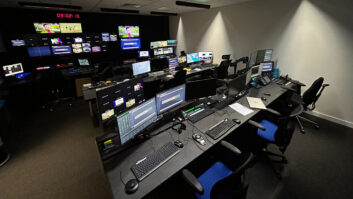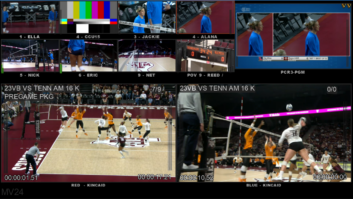
At this year’s Mobile World Congress in Barcelona, much of previous years’ hype and heat on broadcast mobile TV had been snuffed out, with the focus now on other ways of getting the service to end users. Analysis by Heather McLean.
With consumer demand for data-intensive services such as mobile video and apps increasing, European operators are faced with the challenge of delivering services that provide differentiation in the marketplace, while managing a growing burden on 3G networks.
The mobile TV strategy in Europe in 2008 was defined around the broadcast standard DVB-H as the preferred technology for mobile broadcasting and built on a subscription fee-based business model, yet nothing has shifted significantly over the past two years in Europe in terms of available spectrum, and therefore, broadcast mobile TV services.
Forget DVB-H
Diana Jovin, vice president for corporate marketing and business development at Telegent Systems, provider of single-chip CMOS solutions enabling free to air and pay per view mobile TV, comments this focus on DVB-H has hampered widespread adoption in the region.
DVB-H requires a significant capital investment in infrastructure and content licensing by operators, and meaningful consumer demand for mobile TV on a subscription basis has failed to materialise. Jovin says streamed TV services are now being explored as an alternative delivery vehicle, but are fuelling similar infrastructure requirement concerns as demand for mobile video grows and the capacity of 3G networks is strained further.
Yet free to air mobile TV provides operators with the opportunity to offer a service to consumers that can deliver differentiation in the competitive European mobile market, notes Jovin. “The service offers operators additional benefits; it doesn’t require capital investment for new infrastructure. Free to air mobile TV provides operators with an offload strategy because it receives transmissions from the existing analogue and digital television networks; and it does not contribute to increased data traffic on networks,” she states.
“The free to air model has emerged globally as a compelling way to drive mobile TV forward,” adds Jovin. “Although a free handset feature might initially seem to be a counterintuitive business model to operators in Europe, the fact that operators can provide consumers with the content they want, without making a huge investment and without overloading already strained networks, translates to a business case worth consideration.”
She continues: “Free to air mobile TV has been rapidly gaining acceptance among consumers in both emerging and developed markets, and across both analogue and digital standards. For 2009, analyst house Forward Concepts estimates that free to air mobile TV accounted for more than 85% of all broadcast TV handsets shipped.”
However, while broadcast mobile TV on DVB-H seems to have died a death in Europe, broadcast standard FLO TV has made inroads in the US, with coverage of over 110 major populations in the sprawling country following on from the US digital switchover in July 2009.
Vikki Mealer, senior director of product management at FLO TV, comments: “The digital TV transition in June was like a chequered flag to us. We now have the coverage, the network and the direct to consumer business model.”
Key US operators AT&T and Verizon allowed handsets in their portfolios for FLO TV to dwindle to just one model each by last December. However, from the beginning of 2010, each operator has placed orders for more models and shipments are rising steadily, claims Mealer.
On moving into Europe, Mealer comments: “We’re cautiously optimistic; someone needs to build a nationwide network and while we did that in the US, we’re looking at creative ways to partner with people for a network build-out in Europe.
“I think some people think mobile TV isn’t viable; they think it’s all hype, and that’s died off. We’re here to say we’re very bullish. We feel strongly about the service and the technology provides a very strong case for broadcasting TV and data also. It’s all about live TV, not streaming,” continues Mealer.
Mobile TV success
Kay Johansson is CTO at MobiTV, which provides whitelabelled, managed mobile TV services as a combined service of steamed, video on demand, local playback, and soon broadcast, mainly in the US to Sprint, AT&T, Verizon and T-Mobile.
MobiTV is one company that has been working quietly in the background of mobile TV since 2003. It has defied the market and now has over nine million mobile TV subscribers to its services. Last year, viewers of its services watched two billion minutes of mobile TV, an increase of 70% to 80% year on year, says Johansson.
MobiTV focuses on pulling all delivery channels together, so the viewer is not aware of the delivery mechanism. Johansson comments: “We don’t believe that separate apps for broadcast and VoD and the rest will work; it’s about personalisation for the individual. We pull everything together into one space for the user.”
Johansson says the MobiTV service is mostly delivered over 3G, also over WiFi, switching seamlessly over those carrier mechanisms. He adds the service is 50/50 VoD and live viewing, with VoD being used until something live, such as sports or news coverage, come on. “People definitely want to see live TV, but specific stuff, not necessarily a show that comes on at 8pm. Sport is very popular.”
Johansson adds: “The thing that’s been so interesting for us in Europe is people say broadcast mobile TV will see X million number of subscribers by 2012, but whatever figure they quote we can say we passed that a long time ago. It’s interesting that in the broadcast mobile TV area, how the focus has been on the technology rather than the service. People don’t realise the size of our operations. We’re expanding into Europe now. Carriers can for sure launch successful mobile TV services and make money out of it, and this is what we do for them; make a mobile TV service.”
Rise of the broadcaster?
With the US digital switchover, another broadcast TV standard has started to move forward. With the US digital switchover, the US equivalent of DVB-H, Advanced Television Systems Committee – Mobile/Handheld (ATSC-M/H), is starting to take off according to Johansson. ATSC-M/H is a standard in the US for broadcast mobile digital TV. As DVB-H and 1seg are mobile TV extensions to the DVB-T and ISDB-T terrestrial digital TV standards respectively, ATSC-M/H is an extension to the available digital TV broadcasting standard, ATSC A/53. Trials of mobile TV on ATSC-M/H began in the Washington area in February this year.
However, the difference between DVB-H and ATSC-M/H is the latter is only able to carry four local channels, so it is to be used for free to air local content, rather than a broader spectrum of programming.
Fautier comments: “Mobile TV is dead; long live mobile video. There is still no business model for DVB-H, while in the US, ATSC-M/H is free, so of course people will take it. However, in my view broadcast TV has very little future, while unicast has a great future as long as it’s not live streaming.”
Boris Felts, vice president of marketing at Envivio, says that mobile network operators have had their moment in the sun with broadcast TV ideas, and failed. He claims it is now time for broadcasters to take IPTV to the masses using side-loaded content, downloaded to the mobile from the internet without touching the mobile network.
“People in Europe have looked into DVB-H for broadcast mobile TV, but have decided to move away from that as it’s too complex. Most people are dropping it and moving to side-loaded on demand instead; networks don’t have the capacity or bandwidth for even streamed TV, so side-loading is the answer,” Felts states.
He adds: “This means broadcasters that don’t have mobile network access can distribute content on the internet, without the need to control a network, and no need for carrier agreements and the like.” Felts continues that this is now a race between broadcasters who have everything to gain, and mobile operators who have everything to lose if they too do not step onto the side-loaded content bandwagon.







